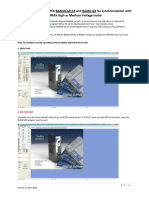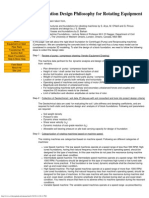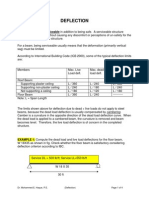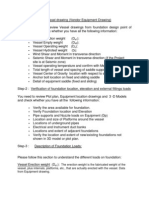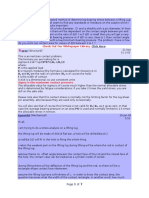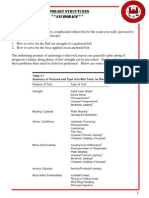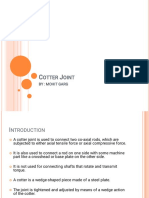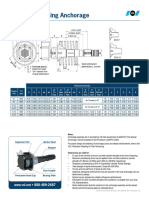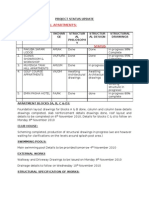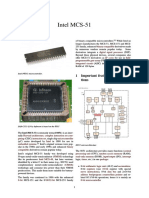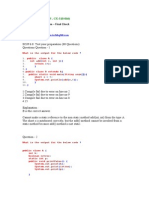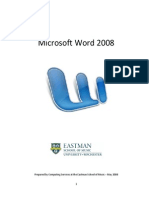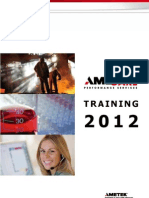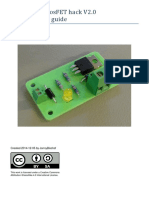Pull Out Strength
Pull Out Strength
Uploaded by
ambryx2001Copyright:
Available Formats
Pull Out Strength
Pull Out Strength
Uploaded by
ambryx2001Copyright
Available Formats
Share this document
Did you find this document useful?
Is this content inappropriate?
Copyright:
Available Formats
Pull Out Strength
Pull Out Strength
Uploaded by
ambryx2001Copyright:
Available Formats
Calculating Anchor Bolt
Pullout Strength
Technical Bulletin # 691B
Bulletin Description
Anchor bolt Pull Out Strength is the force required to pull a single bolt out of its foundation. The
separation can occur between the epoxy grout and the concrete foundation or it can occur between the
anchor bolt and the epoxy grout itself. This bulletin provides the formulas needed to calculate the force
required to pull an anchor bolt out in either manner.
To calculate the Total Pull Out Strength of the entire machine, multiply the force required to pull one bolt
out times the total number of bolts.
When calculating Pull Out Strength it is assumed that:
1. A clean, threaded rod or bolt with a coarse surface profile is used.
2. A nut and washer are installed at the bottom of the rod to act as a mechanical interference.
3. The anchor bolt hole is clean and dry, with no contaminants.
Bond Strength Epoxy to Concrete
The bond of the epoxy grout to the concrete
foundation is stronger than the bond of the concrete to
itself. Typically, concrete will separate next to the bond
line of the epoxy and concrete. Therefore, the weakest
link in the bond of epoxy to concrete is the concrete
itself. The force required to pull concrete apart is
called its Shear Strength. A conservative value for
concrete shear strength is 800 psi. To determine the
force required to pullout the bolt separating it at the
epoxy to concrete bond, use the following calculation:
Force = D x x L x 800 psi
Where:
Bond between
F = Bolt Pullout Force in lbs. L the epoxy and
D = Grout Hole Diameter in inches the concrete
L = Length in inches of the grout hole D breaks
= 3.1415
Below are examples of the force required to pull out
various size bolts out of various size holes.
PULL OUT STRENGTH IN POUNDS
BOLT LENGTH
HOLE
3” 4” 5” 10”
DIAMETER
5/8" 4,710 6,280 7,850 15,700
3/4" 5,650 7,530 9,420 18,840
1" 7,530 10,050 12,560 25,130
1.5" 11,309 15,070 18,840 37,690
2.0” 15,070 20,100 25,130 50,260
ITW POLYMER TECHNOLOGIES
130 Commerce Drive Montgomeryville, PA 18936 215-855-8450 Fax 215-855-4688
www.chockfastgrout.com www.escoweld.com
Calculating Pull-Out Strength
Bulletin No. 691B, Page 2
Bond Strength Epoxy to Steel
The bond of grout to the steel anchor bolt can be calculated
using 1600 psi as the Bond Strength of epoxy to steel. This
too is also a conservative number. To determine the force
at the grout-to-bolt interface, use the following calculation:
F = BD x x L x 1600 psi
Where:
F = Bolt Pullout Force in lbs.
D = Bolt Diameter in inches
L = Length in inches of the bolt embedded in grout
(does not include the portion of the bolt that is
wrapped with tape or inside a bolt sleeve.
= 3.1415
Examples of the force required to separate a bolt from the
surrounding epoxy assuming there is no nut.
PULL OUT STRENGTH IN POUNDS
GROUTED BOLT LENGTH D
BOLT L
3” 4” 5” 10”
DIAMETER Bond between
3/8" 5,650 7,530 9,420 18,840 the epoxy and
1/2" 7,540 10,040 12,560 25,120 the anchor bolt
breaks
3/4" 11,300 15,070 18,840 37,680
1" 15,070 20,100 25,130 50,260
1.5" 22,610 30,150 37,690 75,380
Pull-Out Strength – Anchor Bolt in Concrete
As a comparison, an anchor bolt set in a concrete foundation will typically crack up
o
and out from the bottom of the bolt at a 45 angle in a cone shaped section. The
force required to pull up this cone shaped section of concrete is the force required
to separate concrete over the total surface area of the cone. The Surface
Area of a Cone (SACone) = Lateral Surface Area of a Right Circular
o
Cone with 45 Sides:
SACone = x 1.4142 x H2 H
The force required to pull the concrete apart
is the Shear Strength of concrete (800 psi)
45° 45°
times the Surface Area of the Cone.
Force lbs = 800 psi x SACone in2
Force lbs = 800 x x 1.4142 x H2 Concrete will break at
about a 45o angle
Date 08/2005
General: Every reasonable effort is made to insure the technical information and Suggestions concerning the use of products are not warranties. The purchaser assumes
recommendations on these data pages are true and accurate to the best of our knowledge at the the responsibility for determining suitability of products and appropriate use. ITW
date of issuance. However, this information is subject to change without notice. Prior versions Polymer Technologies’ sole liability, for breach of warranty, negligence or otherwise, shall
of this publication are invalid with the release of this version. Products and information are be the replacement of product or refund of the purchase price, at ITW Polymer
intended for use by qualified applicators that have the required background, technical Technologies’ election. Under no circumstances shall ITW Polymer Technologies be liable
knowledge, and equipment to perform said tasks in a satisfactory manner. Consult your local for any indirect, incidental or consequential damages.
distributor for product availability, additional product information, and technical support. Modification of Warranty: No distributor or sales representative has the authority to
Warranty: ITW Polymer Technologies, a division of Illinois Tool Works Inc., warrants that its change the above provisions. No change in the above provisions will be valid unless in
products meet their printed specifications. This is the sole warranty. This warranty expires writing and signed by an officer or the Technical Director of ITW Polymer Technologies.
one year after product shipment. No term of any purchase order shall serve to modify any provision of this document.
Warranty Claims: If any product fails to meet the above, ITW Polymer Technologies will, at Mediation and Arbitration: If any dispute arises relating to products or product
its option, either replace the product or refund the purchase price. ITW Polymer Technologies warranties, either the purchaser or ITW Polymer Technologies may a) initiate mediation
will have no other liability for breach of warranty, negligence, or otherwise. All warranty under the then current Center for Public Resources (CPR) Model Procedure for
claims must be made in writing within one year of the date of shipment. No other claims will Mediation of Business Disputes, or b) initiate a non-binding arbitration under the rules of
be considered. the American Arbitration Association for the resolution of commercial disputes.
Disclaimer: ITW Polymer Technologies makes no other warranty, expressed or implied, and
specifically disclaims any warranty of merchantability or fitness for a particular purpose.
You might also like
- Kiswahili Grammar - Mwanasimba OnlineDocument236 pagesKiswahili Grammar - Mwanasimba OnlineRebekah Pelkman100% (26)
- Emrax Unitek Bamocar d3 Bamo d3 Parameters 1.2 April 2014 NDocument9 pagesEmrax Unitek Bamocar d3 Bamo d3 Parameters 1.2 April 2014 NAndres AndradeNo ratings yet
- SS Cse 01Document191 pagesSS Cse 01Senthil SivasubramaniamNo ratings yet
- Section 1630 - Minimum Design Lateral Forces and Related EffectsDocument1 pageSection 1630 - Minimum Design Lateral Forces and Related EffectsAbdul Rauf100% (1)
- EMT757ADocument4 pagesEMT757Atm5u2rNo ratings yet
- Balanza para Extraccion de Sangre AE-500A - V2 Manual de Servicio TecnicoDocument43 pagesBalanza para Extraccion de Sangre AE-500A - V2 Manual de Servicio TecnicoMike Sanchez33% (3)
- Anchor Bolt: Steel Structures in IndustryDocument15 pagesAnchor Bolt: Steel Structures in Industryvenugopal BedadakotaNo ratings yet
- Anchor Bolt Design PhilosophyDocument6 pagesAnchor Bolt Design Philosophyprabhu81100% (1)
- Seismic Response of Ground-Supported Circular Concrete Tanks (2012) - ThesisDocument338 pagesSeismic Response of Ground-Supported Circular Concrete Tanks (2012) - ThesisJulio Humberto Díaz Rondán100% (1)
- Seismic Design of Liquid-Containing Concrete Structures and Commentary (ACI 350.3-06)Document35 pagesSeismic Design of Liquid-Containing Concrete Structures and Commentary (ACI 350.3-06)cassiosNo ratings yet
- Astm C597 02Document4 pagesAstm C597 02kiranNo ratings yet
- Anchor Bolt For ShearDocument22 pagesAnchor Bolt For ShearAnonymous P73cUg73LNo ratings yet
- Machine Foundations 1Document36 pagesMachine Foundations 1eqa amirNo ratings yet
- Concrete Jacket CampioneDocument14 pagesConcrete Jacket CampioneI Komang Danu WinathaNo ratings yet
- UFC 3-310-04 Seismic Design For Buildings (06!22!2007)Document245 pagesUFC 3-310-04 Seismic Design For Buildings (06!22!2007)Bob VinesNo ratings yet
- Civil Design HelpDocument4 pagesCivil Design HelpRanjan ParajuliNo ratings yet
- Thickness Calculation of Annular Base PlateDocument2 pagesThickness Calculation of Annular Base PlateRam Chandra100% (1)
- Staad Response SpectrumDocument5 pagesStaad Response Spectrumturbobrik0% (1)
- Har-Bach Marketing, Inc. Padeye Evaluation Safety Warnings/Instructions Project 21721Document12 pagesHar-Bach Marketing, Inc. Padeye Evaluation Safety Warnings/Instructions Project 21721Damar Budi LaksonoNo ratings yet
- Lifting Systems Design CriteriaDocument8 pagesLifting Systems Design CriteriatfvnjyNo ratings yet
- Precast Concrete Lifting Anchor SystemDocument4 pagesPrecast Concrete Lifting Anchor SystemRachmat Hidayat SapwariNo ratings yet
- Dinamic Analysis of SupportDocument7 pagesDinamic Analysis of SupportlizhasayangNo ratings yet
- Enforced ButtDocument2 pagesEnforced ButtSwati DhurpateNo ratings yet
- Fabrication TolerancesDocument6 pagesFabrication TolerancesRene Alfonso BeltranNo ratings yet
- Local Failures On Coped Steel Beams - A State-Of-Art ReviewDocument16 pagesLocal Failures On Coped Steel Beams - A State-Of-Art ReviewAndré Luiz Nogueira100% (1)
- CivilBay Anchor Bolt Design Example Anchor Bolt Design Spreadsheet ACI 318-08 AISCDocument157 pagesCivilBay Anchor Bolt Design Example Anchor Bolt Design Spreadsheet ACI 318-08 AISCjromero_rpg100% (1)
- Typical Limit of DEFLECTIONDocument4 pagesTypical Limit of DEFLECTIONfreddielistoNo ratings yet
- Iso 3010Document8 pagesIso 3010asvenk3090% (1)
- Spring Mass Model For Seismic AnalysisDocument12 pagesSpring Mass Model For Seismic AnalysisPrakash SIngh RawalNo ratings yet
- CISC Steel Design Series: ULC and cUL Spray-Applied Fire-Rated DesignsDocument11 pagesCISC Steel Design Series: ULC and cUL Spray-Applied Fire-Rated DesignsOussama AMARINo ratings yet
- Foundation Design Philosophy For Horizontal VesselDocument6 pagesFoundation Design Philosophy For Horizontal VesselKeaten ClaneyNo ratings yet
- Edoc - Pub - Foundation Design Philosophy For Rotating EquipmenDocument8 pagesEdoc - Pub - Foundation Design Philosophy For Rotating Equipmensushant_jhawerNo ratings yet
- One Way Joist FlorrDocument15 pagesOne Way Joist Florrak47_uziiNo ratings yet
- Bearing Stress Between A Lifting Lug and A Shackle PinDocument7 pagesBearing Stress Between A Lifting Lug and A Shackle PinYl WongNo ratings yet
- One Way SlabDocument69 pagesOne Way Slabforlogin018No ratings yet
- 05120-Structural SteelDocument10 pages05120-Structural SteelHusen ZahranNo ratings yet
- Anchor BoltsDocument8 pagesAnchor BoltsRalf SnellNo ratings yet
- Hilti Rebar 2Document69 pagesHilti Rebar 2Jeevan ShendreNo ratings yet
- Concrete Pull Out Check PDFDocument1 pageConcrete Pull Out Check PDFMaliki MuhammedNo ratings yet
- Anchor Bolt Design GuideDocument82 pagesAnchor Bolt Design GuideEm Mar100% (6)
- Chockfast Grouted AnchorsDocument3 pagesChockfast Grouted AnchorsSandesh Basnet100% (1)
- Bulletin: Calculating Anchor Bolt Pullout StrengthDocument3 pagesBulletin: Calculating Anchor Bolt Pullout StrengtharsalanNo ratings yet
- 1.3 Design Data - SD 672 New Final - PDF 02-04-2018Document19 pages1.3 Design Data - SD 672 New Final - PDF 02-04-2018simon maaaklaNo ratings yet
- Prying Action: ARCH 6343 Report #2Document19 pagesPrying Action: ARCH 6343 Report #2govindarajan017No ratings yet
- EP PlateDocument6 pagesEP Plateraghav abudhabiNo ratings yet
- Anchorage: Temporary StructuresDocument4 pagesAnchorage: Temporary StructuresShafiullah KhanNo ratings yet
- Girder DesignDocument129 pagesGirder Designshashi rajhansNo ratings yet
- Design of Bolted ConnectionsDocument15 pagesDesign of Bolted ConnectionsAritroNo ratings yet
- Wisser Bridge 2000Document12 pagesWisser Bridge 2000amraja2001No ratings yet
- Bond, Anchorage & Development LengthDocument20 pagesBond, Anchorage & Development LengthS. M. ZAHIDUR RAHMAN 1301129No ratings yet
- Sole PlatesDocument12 pagesSole Platesjonodo89No ratings yet
- Design of Joints (Cotter + Knuckle) PDFDocument80 pagesDesign of Joints (Cotter + Knuckle) PDFDhruv PancholiNo ratings yet
- CE135 - 7. TorsionDocument34 pagesCE135 - 7. TorsionApril ImNo ratings yet
- Base Plate With BoltsDocument3 pagesBase Plate With BoltsAbu KhatriNo ratings yet
- 5 Design of Steel Connections BoltsDocument16 pages5 Design of Steel Connections BoltsSimaoNo ratings yet
- MF & SMO 14th SEP 2022 WTMDocument60 pagesMF & SMO 14th SEP 2022 WTMDeepak KumarNo ratings yet
- Simple WeldDocument7 pagesSimple Weldshantanu chowdhuryNo ratings yet
- Anchorage: Temporary StructuresDocument4 pagesAnchorage: Temporary StructuresEng TrNo ratings yet
- 07 Couplings 2Document8 pages07 Couplings 2fonsekapdlNo ratings yet
- Rigid PavementDocument48 pagesRigid PavementashoknrNo ratings yet
- 03 Cotter JointDocument22 pages03 Cotter JointTeaching ClubNo ratings yet
- VSL Datasheets DuraStorDocument10 pagesVSL Datasheets DuraStormoezartNo ratings yet
- Column confining+reinf+as+per+IS-13920Document5 pagesColumn confining+reinf+as+per+IS-13920raghav abudhabiNo ratings yet
- TIE2208200908 Engineering Design Applications IIDocument4 pagesTIE2208200908 Engineering Design Applications IIPatrick NdlovuNo ratings yet
- Vision 2040Document136 pagesVision 2040ambryx2001No ratings yet
- KCCA - CertificateDocument1 pageKCCA - Certificateambryx2001No ratings yet
- Profiles IPE AA Are Produced According To The Following StandardDocument2 pagesProfiles IPE AA Are Produced According To The Following Standardambryx2001No ratings yet
- Slab Surface Prevention RepairDocument16 pagesSlab Surface Prevention Repairambryx2001No ratings yet
- F E D C B A: Truss 'T1' Truss 'T1'Document1 pageF E D C B A: Truss 'T1' Truss 'T1'ambryx2001No ratings yet
- Project StatusDocument2 pagesProject Statusambryx2001No ratings yet
- DwgsDocument1 pageDwgsambryx2001No ratings yet
- Subsurface DrainageDocument10 pagesSubsurface DrainageAbdul Hameed ArwaniNo ratings yet
- Experiment 3Document12 pagesExperiment 3ambryx2001No ratings yet
- Erroticaarchives Jenni Celiare PDF 2010 No Al Cierre de Webs PDFDocument2 pagesErroticaarchives Jenni Celiare PDF 2010 No Al Cierre de Webs PDFMarioNo ratings yet
- Self-Cutting Screws enDocument10 pagesSelf-Cutting Screws enFederico.IoriNo ratings yet
- GIGABYTE GeForce 210 Video Card Manual - 3Document32 pagesGIGABYTE GeForce 210 Video Card Manual - 3Pedro Vera100% (1)
- Asterisk CLI - Voip-InfoDocument4 pagesAsterisk CLI - Voip-InfoLinuxManCRNo ratings yet
- Inovance Am600 PLC Hardware Manual English 20 4 20Document133 pagesInovance Am600 PLC Hardware Manual English 20 4 20NunNo ratings yet
- Z 86 e 0412Document44 pagesZ 86 e 0412MahadevNo ratings yet
- EBS Report Manager MaintenanceDocument4 pagesEBS Report Manager MaintenanceahsumonbdNo ratings yet
- ReadmefirstaaaaDocument8 pagesReadmefirstaaaaTarun CousikNo ratings yet
- Intel MCS 51Document10 pagesIntel MCS 51Anonymous E4Rbo2sNo ratings yet
- Final Set - Final Check SCJP QuestionDocument41 pagesFinal Set - Final Check SCJP Questionsanjuindia2005No ratings yet
- Paradise Datacom Indoor GaN 4RU SSPA DatasheetDocument8 pagesParadise Datacom Indoor GaN 4RU SSPA DatasheetarzeszutNo ratings yet
- 7162 en 06Document10 pages7162 en 06Mauro Portugal LagardaNo ratings yet
- Microsoft Word 2008-EBookDocument18 pagesMicrosoft Word 2008-EBookBakrudeen Ali AhamedNo ratings yet
- MetronomeDocument8 pagesMetronomeonce666No ratings yet
- Supply Chain ManagementDocument2 pagesSupply Chain ManagementPankaj KothariNo ratings yet
- Trainingcourses 2012 enDocument8 pagesTrainingcourses 2012 enSudhakar VarmaNo ratings yet
- Computer AwarenessDocument82 pagesComputer AwarenesshacknaNo ratings yet
- RAMC User's Manual (ROTAMETER - Yokogawa)Document136 pagesRAMC User's Manual (ROTAMETER - Yokogawa)dj22500No ratings yet
- Computer Systems Architecture Assignment 1 Report: 1. Definition: (P1, P3, M1)Document15 pagesComputer Systems Architecture Assignment 1 Report: 1. Definition: (P1, P3, M1)Dũng NguyễnNo ratings yet
- Oct-Voxy Falla EnecendidoDocument6 pagesOct-Voxy Falla EnecendidoDavid ParariNo ratings yet
- Edsg04-823 (1) - FTKS50-60 PDFDocument73 pagesEdsg04-823 (1) - FTKS50-60 PDFPH Lim100% (1)
- Equipment and CalibrationDocument17 pagesEquipment and CalibrationLyne LerinNo ratings yet
- Pioneer Anh p9rDocument79 pagesPioneer Anh p9rБоро КнежевићNo ratings yet
- HP Laptop Details 22Document1 pageHP Laptop Details 22RAHUL SINGHNo ratings yet
- Heated Bed MosFET Hack V2 - PCB AssemblyDocument12 pagesHeated Bed MosFET Hack V2 - PCB AssemblyDimas NugrohoNo ratings yet
- Owner'S Manual: Please Do Not Return This Product To The Store!Document17 pagesOwner'S Manual: Please Do Not Return This Product To The Store!Craig MalthouseNo ratings yet
- Kendall7e - ch10 Preparing The Systems ProposalDocument70 pagesKendall7e - ch10 Preparing The Systems ProposalMeynard BaptistaNo ratings yet

